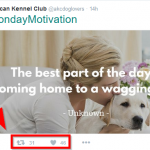More than 80 percent of businesses use social media websites like Facebook and Twitter for their content marketing, and according to a Forbes survey, 90% of businesses feel strongly about its place in a marketer’s repertoire. But using social media, and using it effectively, are two completely different stories.
In the Forbes report mentioned above, the same companies reported incredibly varying results with using social media in their marketing, and the only consensus was that they found it important… not necessarily that it was very effective or produced a high ROI.
So to help you perform better with your social media marketing, we’ve collated a wide variety of tips and tricks to ensure that you’re getting the most out of your social media content marketing, whether you’re running a blog, a local retail website, or a selective set of online services.
Don’t Waste Time on Activities With No Metrics
Dozens of companies help provide more detailed metrics on the social media activities you engage in; and for a good reason. Most social media websites provide incredibly sparse analytics on what’s happening with your posts or ads, and most marketers rely on Google analytics to pick up the slack and help make the ROI on social media activities measurable.
Whether you’re using a free plugin, a paid piece of software, or pixels to track activity, always ensure that you have some way to gather data and analytics on everything you’re doing on social media. Because without looking at data to help parse what’s successful from what’s not, you’ll just continually be throwing spaghetti at the wall and guessing at what’s really ‘sticking’. Split-testing with detailed analytics can help teach you what elements make a good post or a great ad, and can make between a 5 and 15% difference in your conversions.
Optimize Your Posts with Care
Every element of the posts you make can alter your ratio of engagements, interactions, and clicks. So ensure that you split-test different post lengths, different kinds of images, and different headlines. For headlines, question CTAs often perform the most strongly, though depending on the industry, viewers can prefer either short or long post lengths. Having high-contrast landscape images on your posts can dramatically increase interactions and clicks, and it’s usually recommended to have text on those images. The times at which you post also have a big impact; experiment with posting five times a day at two or three-hour intervals.
Pick Your Posts Carefully
Many marketers often reach a point where they aren’t certain what kind of posts to make! But believe it or not, many of the most popular posts on social media all share one thing in common: they educate their readers! Provide value to your audience by teaching and educating them, and resolving problems they might be experiencing within your niche.
Leverage Your Audience
If you have an established audience, leverage them for more than just conversions and engagements! They can help you with SEO and online reputation management. One critical element to any social media campaign should be semi-regular callouts and requests for honest reviews, which can not only help your brand perform better in SERPS, but can also ensure that potential visitors more quickly establish a trust relationship.
The 2-min. video demo of our Strategist speaking to a field. The #funny bit starts at :58 in. #SEO #PublicRelations https://t.co/78zGK3jARv
— Reputation X (@reputationx) May 2, 2016
The Takeaway
Optimizing your social media activities can be rather laborious, and usually takes having a good plan of action. Incorporating analytics is the first step, as it allows you to compare the efficacy of your post split-testing. It can help you identify the optimal post orientation, headers, image types, and posting times. But you shouldn’t forget to leverage an audience for more than just engagement; they can help you with other marketing tasks, as well.



